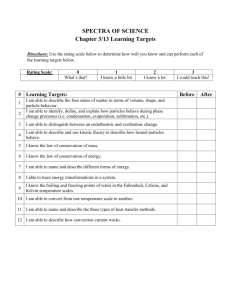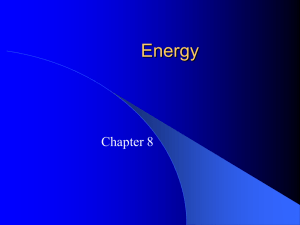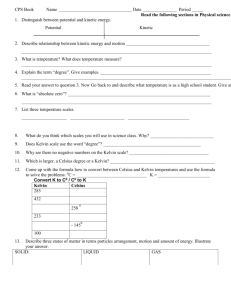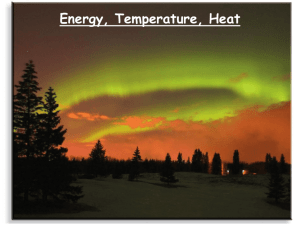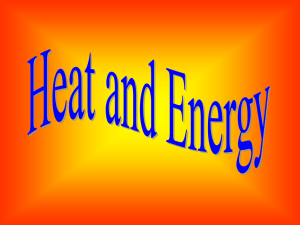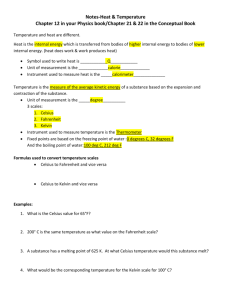Temperature & Matter - Santa Susana High School
advertisement
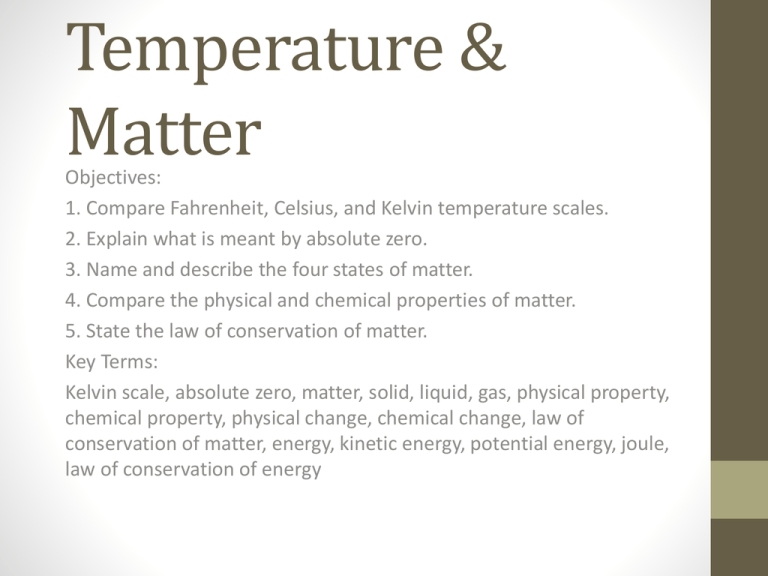
Temperature & Matter Objectives: 1. Compare Fahrenheit, Celsius, and Kelvin temperature scales. 2. Explain what is meant by absolute zero. 3. Name and describe the four states of matter. 4. Compare the physical and chemical properties of matter. 5. State the law of conservation of matter. Key Terms: Kelvin scale, absolute zero, matter, solid, liquid, gas, physical property, chemical property, physical change, chemical change, law of conservation of matter, energy, kinetic energy, potential energy, joule, law of conservation of energy Temperature • There are three major systems in use for measuring temperature. • The Fahrenheit (F) scale named after Gabriel Fahrenheit. The F scale quickly became accepted mostly due to the availability of his thermometers. • The Celsius (C) scale was developed by Anders Celsius. The scale was based on the properties of water. 0oC is the freezing point of water and 100oC is the boiling point of water. Despite the popularity of the F scale, the use of C quickly became the standard for scientist. • The final scale, which is listed in the SI index for temperature, was developed by William Thompson, Lord Kelvin. The Kelvin (K) scale is based on the theoretical concept of absolute zero. Absolute zero is the point where the atomic particles of matter loose their kinetic energy. Some significant aspects of this system are: • All the numbers are positive • The K degree is the same size as the C degree. (Each increase in C by one degree is and increase in one degree K) • K = 273 + C Matter • Matter is anything that takes up space or more specifically anything that has mass and volume. Density, therefore, is the measure of matter since it is the measure of an item’s mass per the volume that object takes up. (density = mass/volume) The following are properties of matter. • Density is considered a property of matter. • It is recorded in g/cc or g/ml depending on whether it is solid or liquid. (SI is kg/m3) • The density of water is 1 g/ml, therefore objects with density less than 1g/ml float and those with density greater than 1g/ml sink. States of Matter • Solids • High density • Density not readily affected by pressure • Holds its shape without borders • Liquids • High density • Density not readily affected by pressure • Adopts the shape of the area around it • Gas • Low density • Density depends on pressure • Expands to fill its container • Plasma • Low density • Density not readily affected by pressure • Expands to fill its container • Exists only at high temperature Physical Properties • Used for identification of a substance • A physical change does not involve the rearrangement of chemical bonds therefore do not alter the identity of a substance • Some basic properties: • • • • • • Color Melting point Boiling point Luster Texture Malleability Chemical Properties • Chemical properties are the result of the bonding arrangement of the atoms that make up a substance • A chemical change causes atoms to be rearranged and alters the identity of a substance (After you burn wood it ceases to be wood.) • Some examples: • Rust • Cooked food • Combustion Conservation of Matter • Matter can neither be created nor destroyed. • This statement by Antoine Levoisier, who is considered the father of modern chemistry, changed the way scientists viewed nature. It's the pattern seen with the Law of Conservation of Energy. What it clearly states is that all chemical reactions can be broken down into their constituent parts, measured and predicted. • All the matter present at the start of a reaction is transferred to the products of the reaction. • Mass reactants = Mass products Energy • Energy is the term used to describe the capacity to produce heat or to do work. • There are two major forms of energy, Kinetic and Potential. • Kinetic Energy (KE) is the energy of motion. When an object is in motion, it carries kinetic energy. • KE = (1/2mv2) • Kinetic energy can also come in the form of mechanical energy (energy created by the gears of a machine) and thermal energy (heat created by the internal motion of particles of matter). • Potential Energy (PE) is the energy of position. • A coiled spring is an example of mechanical PE • Water stored in a water tower is an example of gravitational PE • Chemicals stored in batteries are all examples of electrical and chemical PE. Conservation of Energy • The Law of Conservation of Energy states that "...energy can neither be created nor destroyed, only changed from one form to another." • What this means is that energy is constantly changing from one form to another. PE from the water in the water tower changes to KE as it flows out. It may be used to turn a large wheel which changes it to mechanical energy. The large wheel may run a generator where the mechanical energy is being turned into electrical PE and heat. As you can see the energy is not lost, simply changed. Measuring Energy • The calorie (cal) is a common unit of measure and is the amount required to raise 1g of water 1oC. It is also the name given to measure of energy in food (Cal). (Cal = 1000cal= 1kcal) The SI unit for energy is the Joule named after the physicist James Prescott Joule. The conversion for the two common measurements is 1cal = 4.184J • Example: An average candy bar contains 200 Calories. • 200C x 1000cal x 4.184J = 8.36 x 105J 1 Cal cal
